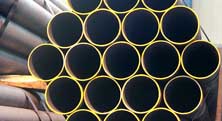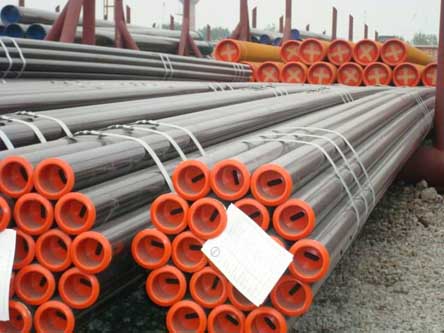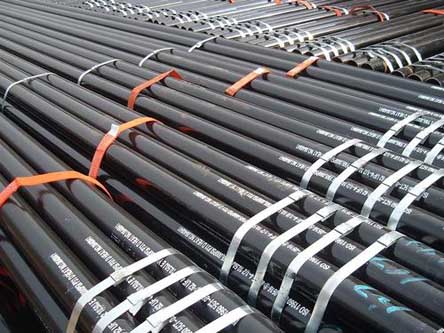 Mild carbon steel Pipe
Mild carbon steel Pipe
 Seamless steel pipe
Seamless steel pipe- pipeline
- OCTG
- ASTM pipe
- API pipe
- Heavy Wall Steel Pipe
- Boiler steel pipes
- Casing and tubing
 Welded steel pipe
Welded steel pipe- spiral steel pipe
- ERW pipe
- SSAW pipe
- DSAW pipe
- LSAW pipe
 Carbon steel pipe
Carbon steel pipe- Black steel pipe
- fluid pipe
- Pipeline Coating,2PE 3PE
- Structural steel pipe
- Mild Steel Pipe
 Alloy pipe
Alloy pipe galvanized steel pipe
galvanized steel pipe stainless steel pipe
stainless steel pipe steel pipe schedule
steel pipe schedule pipe fittings
pipe fittings
Mild steel pipe

The most frequently used mild steel are ASTM
A-106 & A-S3. A-106 comes under both A & B grade and
is used for cold or close coiling.
Mild steel contains carbon alloy of 0.16 to 0.29%
and is therefore not ductile. The mild steel pipes
hardness of the mild steel could be increased
through carburizing in which the steel is heated
below melting point in presence of another material
and again by quenching, the outer surface of the
carbon becomes harder maintaining a soft core.
The different variations of carbon
steel pipe fittings and pipes are measured by their
percentage of carbon content that has been mixed
with iron. Here is a quick list of the categories:
Mild carbon steel: 0.05-0.15
Low carbon steel: 0.16-0.29
Medium carbon steel: 0.30-0.59
High carbon steel: 0.60-0.99
Ultra-high carbon steel: 1.00-2.00
ASTM A-106 Gr. B, A-333 Gr. 6, BS 3059, ASTM A 53, API 5L .
API 5L - A,B, X - 42, 46, 52, 56, 60, 65, 70 Etc.
In Form :
Round, Square, Hydraulic Tube & Horn Tube.
Mild steel pipe Availability and usages:
Mild steel is available in a variety of structural
shapes that are easily welded into pipe, tube,
tubing etc. Mild steel pipes and tubing are easy to
fabricate. The life expectancy of such steel could
go up to 150 years if it is well protected. Mild
Steel pipes and tubing are used for structural
purpose and mechanical & general engineering
purpose. It is also used for drinking water supply
and the use of chlorination and sodium silicate
inhibit corrosion in mild steel pipes.

|
Material |
Size |
Sch. & Swg. |
Specification |
|
Seamless Pipe |
15 NB To 150 NB |
Sch. 40s to Sch. XXs |
ASTM A 53 A / B, A-106 Gr. A,B,C |
|
Welded (ERW) Pipe |
15 NB To 150 NB |
Sch. 40s to Sch. XXs |
ASTM A 53 A / B API 5L |
|
Low Temperature |
15 NB To 500 NB |
Sch. 40s to Sch. XXs |
A-333 Gr. 6 Seamless |
New Update Pipe List
The difference between the Pipeline, heat-resistant steel pipe, machinery and industrial pipe, oil casing pipe.
The technical galvanized steel pipe achieved 1, grade and chemical composition Steel grades and chemical composition of galvanized steel should be consistent with the GB 3092 clarinet steel grades and chemical composition..
DIN2448 DIN1629 steel pipe: DIN2448/1629 Grade: ST37, ST44, ST52 Size: from 1/4" to 28", OD from 13.7 mm to 711.2 mm .
Hot Click PRO
-
s
We are Exporting wide range of Mild Steel Tubes, Mild Steel Pipes, MS Pipes, Mild Steel Galvanized Pipes for various purposes. Apart from the following standard range of products we also manufacture customized products as per the requirement. s
Q195-Q235 Mild Steel Square Pipe,ERW Carbon Steel Black Square Welded PipesSteel Grade:Q195App:Furniture/ConstructionPipe WT:0.45-4.75mmSample Free. s
MS Pipe,A53 MS Pipes,MS Tube Schedules:Sizes: Dia : 1/2 " to 8" Thickness : 1.00 mm - 5.40 mm. s
Rolling perforated gross Mild Steel Pipe quality reasons Analysis Prevention. s
MS square steel pipe,Black welded square steel pipe 1. Out Diameter: 15*15-300*300mm2. Thickness: 0.5-15.0mm3. Steel Grade: Q195-Q345, 10#-45#4. Standard: GB/T 3091-2001, BS1387-1985, DIN EN10025, EN10219.. s
ms steel pipe,MS STEEL PIPE ,1:ASTM A106/A53-B API5L-B ,2:OD:20-159mmWT:2.5-20mm ,3:Certificates:ISO & API ,4:Hot rolling.
- Carbon steel pipe Standard
- ASTM A106 pipe
- ASTM A53 pipe
- ASTM A192 pipe
- ASTM A252 pipe
- ASTM A179 pipe
- DIN 1629 pipe
- DIN 17175 pipe
- Alloy pipe Standard
- ASTM A335 pipe
- ASTM A210 pipe
- ASTM A213 pipe
- ASTM A234 pipe
- ASTM A519 pipe
- Stainless pipe metrial
- 304, 304L, 304SS pipe
- 310, 310S pipe
- 316, 316L pipe
- Pipe Fitting Metrial
- Carbon steel: A234 WPB pipe
- Stainless steel: 304,316 pipe
- Alloy steel: A234 WP5 WP9 WP11 WP22 pipe

